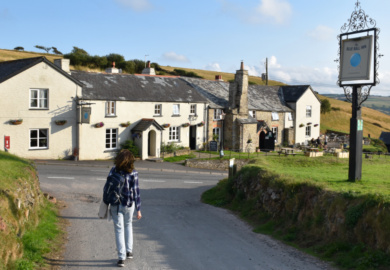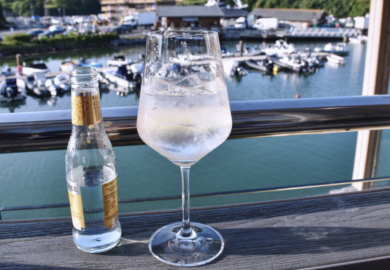Wherever we end up laying our hats, we always enjoy discovering what’s especially tasty in the local culinary scene. In the north of Tenerife, an island unfairly defined for having food that was a mirror of Britain’s, we discovered a rich vein of regional specialities that never made it into travel articles. In Portugal, we found the food served in traditional restaurants where we lived in Sétubal/Palmela was far more varied than the dishes which made it onto many travel lists. Returning to Britain wasn’t likely to throw up anything new, nevertheless it has been an education over the last couple of years getting to know the best things to eat and drink in Devon, Somerset, and Cornwall.
One of the surprises was that in terms of the availability of local produce, living in Somerset near the border with Devon isn’t massively different from the worlds we experienced in both Spain and Portugal. There are lots of small-scale local producers. We buy our honey from the man who produces it at the market in Wiveliscombe, and a fishmonger delivers fish and seafood direct to our front door. When we lived on a farm in Devon, milk from a nearby farm was delivered, people dropped off various vegetables they grew themselves, and we regularly had lamb chops and pork sausages from surrounding farms passed through the window.
Living abroad, one of the things we missed about Britain was the idea of convivial country pubs, not that there were many of those where we lived in Stockport. Here, we’re spoiled, most of them serving great food, perfect venues for becoming acquainted with the best of the south west’s food and drink.

Pasties
I’m a pastry freak, so much so that when I was young, I’d take the meat out of Scotch pies and just eat the crust. Pasties are right up my street. The traditional way to eat them is to hold the crimped crescent and eat the rest. Authentic Cornish pasties should only contain roughly diced or minced beef, sliced or diced potato, swede (turnip if you’re Scottish), onion, and seasoning. The only proper Cornish pasties are made west of the Tamar and have a blue label identifying them as ‘Protected Geographical Indication.’ However, some of the best pasties I’ve tried came courtesy of someone who’d been in the navy and bought them from the docks in Plymouth. They were huge, peppery, and bulging with ingredients.

Scones, clotted cream, and jam
The controversial trio. Do you put the cream or jam first? In Devon, it’s cream. In Cornwall, it’s jam. In Somerset, it’s … whatever you fancy. The Rambler’s Rest tearoom on Exmoor near Lynton straddles both Devon and Somerset. How you should eat your cream scone depends on where you sit in the tearoom. I’m a clotted cream first fan simply because it makes more sense. Clotted cream has more of a consistency of butter. I’ve discovered there are a lot of substandard cream teas about, so it’s not always a given you’ll get a good one. One of the best I’ve had was in the enchanting garden at the Dunsford Tearoom on the edge of Dartmoor.

Devon crab
South Devon is famous for its crab, with some claiming it is among the best in the world. I don’t know about that. What I do know is that having tasted and been underwhelmed by crab in various other locations, it wasn’t until I tried Devon crab at the Crab Shed in Salcombe, where the crab is landed on the quay beside the restaurant, that I finally understood why so many people rave about crab meat.

Cornish sardines
Having lived just south of Lisbon, where sardines are so worshipped there are festas in their honour, I’m a big fan. So, it was a pleasant surprise to find Cornish sardines on sale in our local supermarket. Maybe the reason I didn’t expect to find sardines here is they were known as pilchards until they were rebranded in the 1990s. A rose by any other name and all that, they look and taste like the sardines I had in Portugal, and they are cheap. Sardine season tends to run from around late July until January.

Cider
I could tell you a rather queasy tale why I’m not keen on cider. I won’t, except to say an experience with the drink put me off it for a long time. Living in cider country meant that I had to try to get over that and dip my tongue in those scrumpy waters again. Needless to say, Somerset cider is not the same cider from my misspent youth. A favourite lunch spot is Sheppy’s Cider Farm at Bradford-on-Tone. It is one of the oldest independent cider makers in the world and a pleasant place to have a wander around. There’s a wide selection ranging from classic to cloudy. On a smaller scale, we enjoy a glass of scrumpy in eclectic Pebbles Tavern in Watchet because they stock cider from the Secret Orchard, which is run by a pair of ‘jumped up country boys’ – their words.

Homity Pie
Also known as Devon pie, there are lots of ‘origin’ stories for this open-topped pie made with potato, cheese, and onion. Some say it’s an Irish import, others that it can be attributed to the Land Girls during WWII, or it was just an old Devon recipe. Potato, cheese, and onion is a bit of a classic combo, so most places have their own variation.

Cheddar Cheese
Cheddar and Somerset is as synonymous as cider and Somerset. Britain’s most popular cheese was created in the village of Cheddar way back in the 12th century. I can’t hear the name Cheddar Gorge without imaging a landscape of rocky ravines made from yellow cheese. There are too many great cheddars to mention, but I’m picking one out– Montgomery Cheddar. Although sharing the same name, I’ve got nothing to do with the Somerset Montgomerys, but their cheese is good. The extra mature is aged for 18 months, giving it a palate-pleasing depth and a bit of a kick.

Somerset brie
Somerset is a great county for cheese monkeys. As well as cheddar, there is creamy brie. The ones we have tried haven’t been quite as pungent as their French counterparts, but they’re still worthy rivals. The best Somerset brie is said to come from the south of the county, around Cricket St. Thomas.

Wine
When we lived on a sheep farm Portugal, the surrounding countryside was full of vineyards. Renting a house on a sheep farm in Devon, we didn’t expect to have similar ingredients, yet there was a vineyard over the hill. The south west has a temperate climate suited to wine production, with Devon alone having 84.5 hectares devoted to vineyards. Wines tend to be predominantly sparkling whites and rosés. They’re not particularly cheap, but it’s nice to splash out every now and again on something sparkly that was produced just up the road.

Ice cream
You get particularly good ice creams in this part of Britain, wonderful creamy affairs that evoke childhood memories. Many of the best I’ve tried are from farms, but a relative who lives in Devon insists Hocking’s is the best of the best. You can only find it on sale in a relatively small area between Ilfracombe and Bideford. We bought our cones from a retro-style van on the beach at Appledore, a real throwback to summer holidays of the past.
And then there are those that haven’t made the list, purely because I haven’t tried them yet. One is hog’s pudding, a type of sausage from Devon and Cornwall that is similar to white pudding. Another is the quite bizarre Cornish stargazy pie – named because whole sardines poke through a pastry crust, their heads facing upwards as though the small fish were staring at the sky. It doesn’t look the most appetising dish, even to someone like me who loves fish and seafood.

